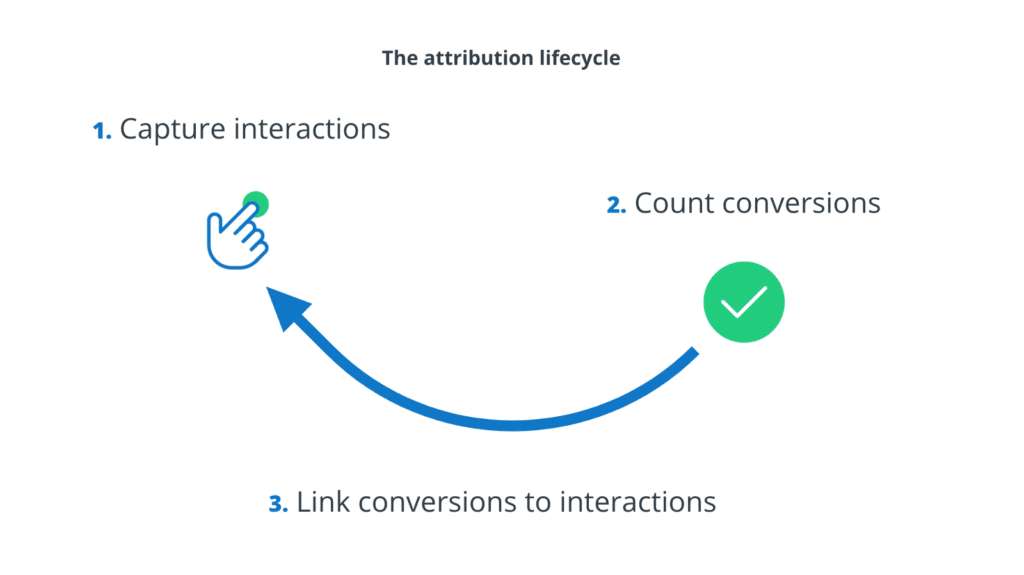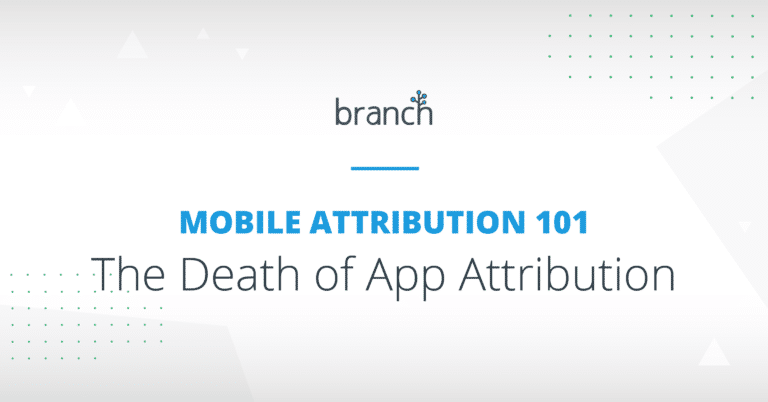This is part 1 in a 3-part series on why the era of the “mobile attribution provider” is coming to an end – and what we can expect from Attribution 2.0. The full article was originally published by Hacker Noon.
Attribution is deceptively difficult. Every mobile marketer considers it critical, and yet many people still feel there is vast opportunity for improvement.
How is this possible? For something that is so important to the modern marketing ecosystem, why are so many of the available options for attribution so disappointing?
The underlying problem is that the mobile attribution platforms we use today are chips off the same old block: technologies that were designed to passively measure a single channel or platform. This is a perfect example of “if your only tool is a hammer, everything looks like a nail.” We need a new toolbox to rebuild attribution in a way that can keep up with our rapidly-changing digital landscape.
The potential of “Attribution 2.0” is enormous. Done well, it is a strategic growth engine that actively helps you grow your business. However, the risks of getting it wrong are just as high: legacy attribution will strangle your growth with broken experiences, misleading data, and inaccurate decisions.

We’re going to explore Branch’s perspective on an ideal Attribution 2.0 solution in five chapters, the first two of which we’ll cover today:
- What does “attribution” even mean? A brief history of marketing attribution, including offline, digital, and mobile.
- How mobile attribution providers became blind. The reason why these platforms are rapidly losing the ability to do their job.
- The future of attribution. How a “persona graph” provides reliable and accurate measurement everywhere.
- Reviewing traditional attribution techniques. A deep dive into how measurement worked in the single-platform worlds of websites and apps.
- The next generation: a persona graph. Why a persona graph works, and how we built one at Branch.
Chapter 1: What does “attribution” even mean?
This chapter is a tour of marketing attribution up until today, covering offline, digital, and the birth of the mobile attribution provider as a separate service. We will review the basic needs of an attribution solution, the evolution of attribution as channels have fragmented, and specific mobile challenges.
If you check the dictionary entry for “attribution,” you’ll find this:
“The action of regarding something as being caused by a person or thing.”
At the most basic level, every marketing attribution system in the world performs three tasks: 1) capture interactions between the user and the brand, 2) count conversions by the user, and 3) link those conversions back to any interactions that — in theory — drove them. When done correctly, this process allows you to figure out if your campaigns are worth the cost.

As we’ll discuss, there’s undeniably now a fourth task: 4) protect against broken user journeys. Attribution is an exercise in futility if anything blocks conversions from actually happening in the first place.
While this sounds straight-forward, it leads to an inherent conflict: tracking every activity and what caused it might sound like paradise to a marketer, but the proliferation of ad blockers, browsers with built-in tracking protections, and new privacy-focused legislation around the world clearly shows that many end users don’t share this perspective.
Attribution has existed for as long as marketing itself, and has its roots in psychological theory: humans are naturally driven to find causes for actions and behaviors. The techniques used to measure marketing campaigns have changed over time, but as we think about the future of attribution, it’s important to recognize that Attribution 2.0 doesn’t mean “x-ray vision to track everything.” What we need is responsible, secure, privacy-focused measurement that can reliably handle the technical challenges of a complicated digital ecosystem.
Attribution version 0: offline
Billboards, TV commercials, newspapers, and other mass-market campaigns all share one thing in common: everyone who sees them gets the same experience. These campaigns are not individualized, and they are not interactive.
This is a problem for accurate attribution, because it means there is no way to deterministically measure the relative influence of each activity. You could use proxy metrics (e.g., “how many people walked past this billboard last week?”), or try to infer attribution data (e.g., “did sales in a given city increase after my TV commercial?”). You could even try to tease out a few extra insights with workarounds like special discount codes or unique phone numbers for each campaign. But all of these techniques are analog and imprecise.
Attribution version 1: digital
[socialpug_tweet tweet=”“Imagine discovering the electric lightbulb, after a lifetime of candles. That’s what happened to attribution when the digital ecosystem burst to life.”” display_tweet=”Imagine discovering the electric lightbulb, after a lifetime of candles. That’s what happened to attribution when the digital ecosystem burst to life.”]
Imagine discovering the electric lightbulb, after a lifetime of candles. That’s what happened to attribution when the digital ecosystem burst to life. New technologies like hyperlinks and cookies made it possible for digital marketers to measure exactly which users encountered a marketing campaign, when and how they interacted with it, and what they did afterwards. Because insights like these are table stakes for attribution today, it’s hard to remember just how big of a breakthrough they were at the time.
In those early days, user journeys were confined to just a single place: the web, on a computer. This was a good thing, because measurement of single-platform customer journeys is a relatively manageable problem. Each marketing channel is responsible for its own attribution: email service providers measure email, ad networks track their ads, and so on. This worked because all channels still led directly back to a website, allowing marketers to string together a conversion funnel that went right down to events representing value (like signups or purchases).
Attribution version 1.5: the birth of the Mobile Attribution Provider
But then, in 2008, Steve Jobs introduced the world to a brand new platform: native mobile apps. In those early days, many mobile marketers (especially in the gaming industry) found that using ads to drive app installs was a sure-fire path to positive ROI. So much so, that other channels and conversions were allowed to fall by the wayside because solving the technical complexity just wasn’t worth the investment.
However, ad install attribution comes with a few significant technical problems of its own: 1) matching, and 2) double attribution.
Matching. The iOS App Store and Android Play Store are attribution black holes. Between the ad click that takes a potential user to download and that user’s first app launch, marketers are completely in the dark. Since the basic definition of attribution is knowing where new users came from, it is critical to find a way around these black holes, in order to connect installs back to clicks that happened earlier. A recent Branch study concluded that poor matching techniques still lead to incorrect attribution rates of over 25%.
Double attribution. With so many ad networks all vying for the same eyeballs, users often interact with multiple ads before successfully installing an app. No marketer likes being charged twice for the same thing, but this is exactly what happens when two different networks make claims for driving the same app install. Industry estimates show that without this deduplication, almost a quarter of campaign spend can be wasted.
To solve these problems, a new type of company appeared: the Mobile Attribution Provider. Using a combination of device IDs and a probabilistic technique known as “fingerprinting” (which slurps up device data like model number, IP address, and OS version to create a signature that may or may not actually be unique), these companies provided “matching magic” to figure out which ad a new user had clicked prior to install.
By centralizing all this conversion data in one place, the mobile attribution providers were able to act as independent advocates on behalf of the marketer, ensuring the right ad network got paid (and only paid once).
Chapter 2: How mobile attribution providers became blind
This chapter discusses why mobile attribution providers are losing relevance in our multi-platform world, how this affects the companies that rely on them, and why user experience is now a critical piece of the attribution puzzle.
In the early years of mobile, getting a user to install an app was all that really mattered. Once users had your icon on their home screens, you’d won. And because the ROI of buying app installs with ads was reliably positive, there was no real need to invest in things like cross-channel acquisition or cross-platform re-engagement.
[socialpug_tweet tweet=”“The DNA of these companies is so tied up in apps and ads that the words ‘app’ and ‘ad’ themselves often show up as part of the company name.”” display_tweet=”The DNA of these companies is so tied up in apps and ads that the words “app” and “ad” themselves often show up as part of the company name.”]
All of the traditional mobile attribution providers on the market today were born during this phase of simple and easy paid growth, which means they all suffer from the same foundational problems:
They’re black-and-white TVs in a Technicolor world. The mobile ecosystem has expanded, but the DNA of these companies is so tied up in apps and ads that the words “app” and “ad” themselves often show up as part of the company name (savvy teams recognized this shift years ago and made investments in rebranding).
They’re passive, third-party bean counters. Because these systems grew out of a single-platform, single-channel mindset, they are designed and built on top of an assumption that the only thing they ever needed to do was stand by and observe. They’re like bureaucrats who only care about one outcome (app installs), and only deal in one currency (mobile ads). The rest of the world does not matter. In our new, multi-platform reality, passive observation is no longer enough.
The ironic result of these issues is that legacy systems increasingly fail to deliver the one thing they were built to provide: accurate measurement.
Missed attribution already leads to real costs
Corrupted data and broken customer experiences can do measurable damage to digital businesses. Here’s a realistic possibility:
You want to buy a new pair of shoes.
Scenario 1: how it “should” work. While scrolling through Facebook, you see an app install ad for discounted shoes, download the app, and then proceed to purchase a pair of sneakers. Everything is fine, because this is the basic app install ad working the way it was designed to.
Scenario 2: how things actually happen in real life. While waiting in line at Starbucks, you start by searching the web for shoes. You’re a regular at this Starbucks, so your phone has automatically connected to the wifi. You see an app install ad and click it, but before the download can finish, your order is called and you walk out of the store without opening the app. You remember about the shoes later that evening and complete the purchase at your computer. Meanwhile, another Starbucks customer opens the same app a few hours later to buy a new hat.
Here’s where things get messy: because your ad click happened on the web, a traditional mobile attribution provider would be forced to use fingerprinting to match your install. And because both you and the unknown other customer have the same iPhone model and were using the same Starbucks wifi network, your device fingerprints will be identical. From the attribution provider’s perspective, a single user clicked the ad, opened the app, and purchased the hat. The web conversion, which was actually driven by the ad, gets tracked as a completely separate customer (if it is even captured at all).
While this particular example is an edge case, that’s the whole point: edge cases are no longer the exception to the rule — they are the rule. Businesses that equip themselves to handle this fragmentation see major advantages over their competitors. Those that don’t end up making critical decisions based on flawed data without even realizing it.
Attribution and user experience are two sides of the same coin
In order to attribute a conversion, that conversion has to happen in the first place. On the web, single-platform user journeys were robust and relatively unlikely to break, but “The Internet” is no longer a synonym for “websites on computers.”
[socialpug_tweet tweet=”“‘The Internet’ is no longer a synonym for ‘websites on computers.’”” display_tweet=”“The Internet” is no longer a synonym for “websites on computers.””]
Today, if you aren’t able to provide the sort of seamless experience your customers want, the cost can be far more than just a lower conversion rate:
I just cancelled my @WSJ subscription after being a reader and subscriber for 39 years. Because they don’t recognize me across my phone or tablet and force me to log in every time. The app works but links from Twitter or elsewhere don’t open the app or deep link. Bye Bye.
— Chris Fralic (@chrisfralic) February 11, 2019
The explosion of new channels, platforms, and devices has fractured the digital ecosystem, but users don’t understand (or care) that this fragmentation causes technical headaches for you. They expect seamless experiences that work wherever they interact with your brand.
This means that these days, attribution is not just a marketer’s problem; it impacts every part of the business, and companies that provide attribution as a service need to take a far more active role than simply sitting on the sidelines, counting beans. Legacy systems that haven’t evolved fast enough are already a major business risk because of potentially missing data, and are silently becoming more of a liability over time as they fail to help improve the business metrics they are supposed to measure.






















